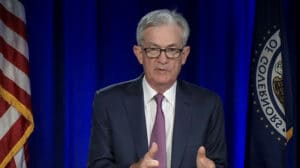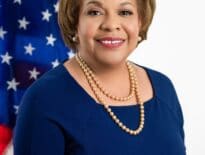
Fed Chair Jerome Powell speaks to reporters during a virtual press conference following the July 27-28 Federal Open Markets Committee meeting. Federal Reserve photo
The Federal Reserve will quicken the pace at which it’s pulling back its support for the post-pandemic U.S. economy as inflation surges, and it expects to raise interest rates three times next year.
In an abrupt policy shift, the Fed announced Wednesday that it will shrink its monthly bond purchases at twice the pace it previously announced, likely ending them altogether in March. The bond purchases were intended to hold down long-term rates to aid the economy but are no longer needed with unemployment falling and inflation at a near-40-year high. The accelerated timetable puts the Fed on a path to start raising rates in the first half of next year.
The Fed’s new forecast that it will raise its benchmark short-term rate three times next year is up from just one rate hike it had projected in September. The Fed’s key rate, now pinned near zero, influences many consumer and business loans, whose rates would likely also rise.
The policy change the Fed announced in a statement after its latest meeting had been signaled in testimony Chair Jerome Powell gave to Congress two weeks ago. The shift marked Powell’s acknowledgement that with inflation pressures rising, the Fed needed to begin tightening credit for consumers and businesses faster than he had thought just a few weeks earlier. The Fed had earlier characterized the inflation spike as mainly a “transitory” problem that would fade as supply bottlenecks caused by the pandemic were resolved.
But the run-up in prices has persisted longer than the Fed expected and has spread from goods like food, energy and autos to services like apartment rents, restaurant meals and hotel rooms. It has weighed heavily on consumers, especially lower-income households and particularly for everyday necessities, and negated the higher wages many workers have received.
In response, the Fed is shifting its attention away from reducing unemployment, which has fallen quickly to a healthy 4.2 percent, down from 4.8 percent at its last meeting, and toward reining in higher prices. Consumer prices soared 6.8 percent in November compared with a year earlier, the government said last week, the fastest pace in nearly four decades.
The Fed’s new policy shift does carry risks. Raising borrowing costs too quickly could stifle consumer and business spending. That, in turn, would weaken the economy and likely raise unemployment.
Yet if the Fed waits too long to raise rates, inflation could surge out of control. It might then have to act aggressively to tighten credit and potentially trigger another recession.
Fed officials have said they expect inflation to cool by the second half of next year. Gas prices have already come off their peaks. Supply chain bottlenecks in some areas are gradually easing. And government stimulus payments, which helped spur a spike in spending that boosted inflation, aren’t likely to return.
Yet many economists expect high prices to persist. That likelihood was reinforced this week by a government report that wholesale inflation jumped 9.6 percent for the 12 months ending in November, the fastest year-over-year pace on records dating to 2010.
Housing costs, including apartment rents and the cost of homeownership, which make up about one-third of the consumer price index, have been rising at a 5 percent annual pace the past few months, economists at Goldman Sachs have calculated. Restaurant prices jumped 5.8 percent in November from a year ago, a nearly four-decade high, partly reflecting higher wage costs. Such increases will likely keep inflation well above the Fed’s 2 percent annual target next year.






